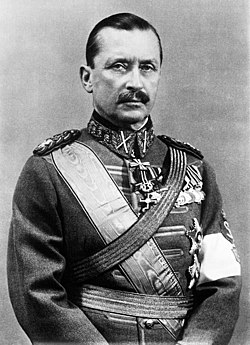Asia
Cambodia
The Social Republican Party was a political party in Cambodia, founded by the then-head of state Lon Nol on 10 June 1972. Its platform was populist, nationalist, and anti-communist, Lon Nol being determined to oppose North Vietnamese and Chinese influence in the region in the context of the Second Indochina War. The party's primary function, however, was to support and legitimise Lon Nol's leadership of the country; he was later to develop a rather ramshackle chauvinist and semi-mystical ideology called "Neo-Khmerism" to back his political agenda. [34]
China
Han Fei's Legalism in the 3rd century B.C. advocated authoritarian conservatism that elevated the position of ruler. [35] Legalism argued that administrative discipline, not Confucian virtue, was crucial for the governance of the state. [36] Modern Chinese conservatism was often accompanied by authoritarianism; the Chinese nationalist party Kuomintang (KMT) originally started out as a social democratic party that advocated Westernization in the Sun Yat-sen period, but Chiang Kai-shek, the leader of the KMT who succeeded Sun, ruled conservative and anti-communist right-wing dictatorship after Shanghai massacre in 1927; After the reform and opening up in 1980s, neoauthoritarianism gained its root in the Chinese Communist Party. Neoauthoritarianism is a conservative political thought that advocates for a powerful centralized state to promote market reforms within the Chinese Communist Party (CCP), a concept that has been described as right-wing and classically conservative, despite including some aspects of Marxist–Leninist and Maoist theories. [37] [38] After Xi Jinping came to power, China has become increasingly culturally conservative, traditionalist and nationalist. [39] [40] [41]
Europe
Belgium
The Rexist Party was a far-right Catholic, corporatist, and royalist political party active in Belgium from 1935 until 1945. [45] In its early period—until around 1937—it tried to win power by democratic means and did not want totally to abolish democratic institutions. During the German occupation of Belgium, it became a fascist movement. [46]
Bulgaria
Zveno was a Bulgarian political organization founded in 1930 by Bulgarian politicians, intellectuals, and Bulgarian Army officers. It advocated for rationalization of Bulgaria's economic and political institutions under a dictatorship that would be independent from both the Soviet Union and the Axis powers. They strongly opposed the Bulgarian party system, which they saw as dysfunctional, and the terror of the Internal Macedonian Revolutionary Organization. King Boris III, an opponent of Zveno, orchestrated a coup through a monarchist Zveno member, General Pencho Zlatev, who became Prime Minister in January 1935. In April 1935, he was replaced by another monarchist, Andrei Toshev.
Germany
The Conservative Revolution was an influential ideological movement during the Weimar Republic. Although usually characterized with terms such as radical, revolutionary, ultra, and romantic, the movement also had elements of authoritarianism. [50] For example, Arthur Moeller van den Bruck published the influential book Das Dritte Reich (1923) in which he advocated a "Third Reich" that would unite all German classes under an authoritarian rule. [51] Within the Weimar Republic, the German National People's Party (DNVP), Kurt von Schleicher and Franz von Papen have been described as authoritarian conservatives. The sympathizers of the authoritarian conservatism, such as Schleicher, had been promoted to President Paul von Hindenburg's entourage since 1925 and represented an important pressure group. [52]
Authoritarian conservatives believed that the party politics were deficient. Instead, they wanted to replace it with a broad "movement" or front to govern the country without the parliamentary involvement. Schleicher, although a major proponent of authoritarian conservatism, considered a dictatorship without a popular backing problematic, fearing a civil war involving both the Communists and Nazis and a possible Polish intervention. He and other authoritarian conservatives did not believe anymore that the masses would go along with the wise authoritarian order. They did not support the active popular participation and the totalitarian integration, but still accepted the need for society rallying around the leaders based on shared political convictions. Therefore, Schleicher turned to Nazis, but he first made an offer to form a coalition government to various groups, including Strasserists, before approaching Adolf Hitler himself. [53]
The authoritarian conservatives sought to use Nazis and later bring them in line with more conservative goals of the DNVP. However, Hitler managed to capitalize on a personal rivalry between Schleicher and Papen, who both served as the chancellors, with President Hindenburg ultimately appointing Hitler as chancellor after Schleicher faced crisis from the Reichstag in January 1933, with Papen being given a "watching brief" as Vice Chancellor. [54] Schleicher was ultimately killed in 1934 during the Night of the Long Knives, while Papen barely escaped death and was devoted to the position of Ambassador of Germany to Turkey.
Portugal
António de Oliveira Salazar and his Estado Novo have been described as authoritarian conservative. [56] In 1933, Salazar denounced fascism as "pagan caesarism" which advocates a "new state which knows no juridical or moral limits". On 29 July 1934, Salazar dissolved the Portuguese fascist National Syndicalists movement and the government's note rejected its "exaltation of youth, the cult of force through so-called direct action, the principle of the superiority of state political power in social life, the propensity for organizing masses behind a single leader". [57] Although the Spanish Civil War radicalized the political situation in the Iberian peninsular and led Salazar to create a youth movement and a paramilitary force which used the Fascist salute, its regime never adopted fascism and instead remained authoritarian Catholic corporatist similarly to the Austria of Engelbert Dollfuss. [58]
Ukraine
The authoritarian Ukrainian State headed by Cossack aristocrat Pavlo Skoropadskyi represented the conservative movement. The 1918 Hetman government, which appealed to the tradition of the 17th–18th century Cossack Hetman state, represented the conservative strand in Ukraine's struggle for independence. It had the support of the proprietary classes and conservative and moderate political groups.




